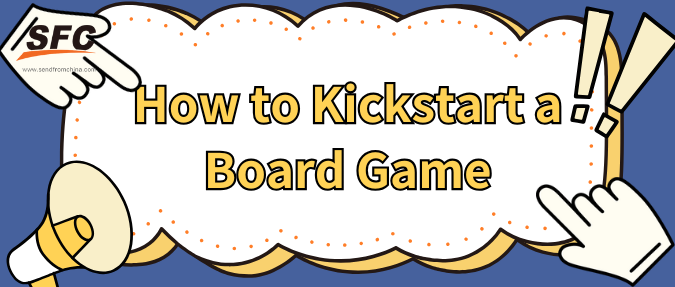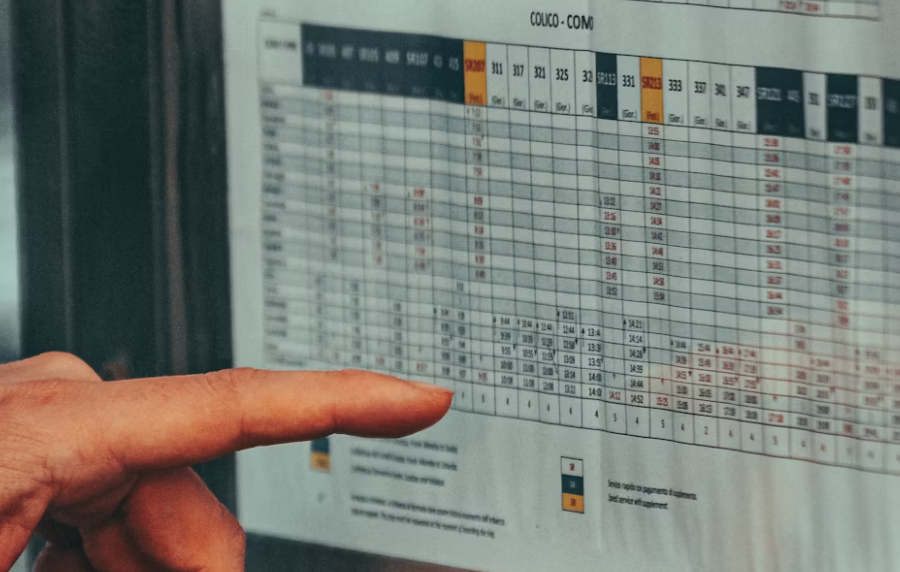Table of Contents
How to Kickstart a Board Game: A Step-by-Step Guide for Creators
Time: Oct 28,2024 Author: SFC Source: www.sendfromchina.com
Kickstarting a board game can be an exciting and fulfilling journey for creators, but it also requires careful planning, attention to detail, and a strategic approach. Launching a board game on Kickstarter involves much more than just posting your game idea online. It’s about creating a compelling narrative, building a strong community, and ensuring that every element—from the game mechanics to the rewards—resonates with potential backers.
This guide will walk you through each step of launching a successful Kickstarter campaign for your board game. From initial planning to post-campaign fulfillment, we’ve got everything you need to know to ensure your campaign is a success.

1. Why Kickstarter is the Best Platform for Board Game Creators
Kickstarter has become synonymous with the board game industry, and for good reason. It offers creators access to a passionate and engaged community of backers who are eager to support new and innovative ideas. With over $1 billion raised for board games, it’s clear that Kickstarter is the go-to platform for creators looking to bring their games to life.
But why is Kickstarter the best platform for board game creators? Here are a few key reasons:
Large, engaged audience: Kickstarter has an established community of board game enthusiasts.
Flexible funding options: With Kickstarter’s all-or-nothing funding model, creators can set realistic funding goals.
Built-in marketing tools: The platform provides creators with tools to easily promote their campaign.
Now, let’s dive into the step-by-step process of planning, launching, and managing your Kickstarter board game campaign.
2. Planning Your Board Game Kickstarter Campaign: A Comprehensive Guide

Before launching your campaign, thorough planning is crucial. A well-thought-out strategy will increase your chances of success. Here’s how to approach the planning stage:
Establish Your Goals and Timeline
Before you even think about launching your campaign, it's essential to establish clear goals for your project. Ask yourself: What is the minimum amount you need to produce your game? What’s your timeline from campaign launch to product delivery?
Start by setting a realistic funding goal that covers production costs, fulfillment, and Kickstarter’s fees. Be sure to factor in potential unforeseen expenses, like customs fees or manufacturing delays. Creating a realistic timeline that includes game development, playtesting, and marketing efforts will ensure a smooth process.
Market Research: Understanding Your Audience
To create a board game that will resonate with backers, you must first understand your target audience. Who are they? What types of games do they typically support? Conducting market research can help you determine which themes, mechanics, and price points are popular among board game enthusiasts.
Use platforms like BoardGameGeek to study the kinds of games that have performed well in the past. Look for trends in game styles, artwork, and campaign features. Don’t forget to participate in board game communities and gather direct feedback.
Prototyping and Playtesting Your Game
A polished prototype is critical to your campaign’s success. Backers want to see that the game they’re supporting has been carefully crafted and tested. Prototyping your game helps ensure that your mechanics work, while playtesting will uncover any balance or design issues.
Start with a rough prototype, then iterate based on feedback from friends, family, and other game enthusiasts. Once you have a more refined version, consider sending it to professional playtesters or influencers in the board game community.
Creating a Marketing Strategy for Kickstarter
Your Kickstarter campaign won’t promote itself—you’ll need a robust marketing strategy to generate interest and attract backers. Start building your audience months before your launch by teasing your game on social media, running email campaigns, and interacting with relevant communities.
Use tools like Kicktraq to analyze similar campaigns and develop strategies that can work for you. Keep in mind that marketing doesn’t stop once your campaign goes live—you’ll need to maintain momentum throughout the campaign’s duration.
3. How to Design a Winning Kickstarter Page for Your Board Game

Your Kickstarter page is your storefront. A compelling page not only draws in potential backers but also convinces them to support your project. Here's how to design a winning Kickstarter page:
Crafting an Engaging Story for Your Game
One of the most important aspects of your Kickstarter page is the story you tell. Potential backers want to know not just about the game itself, but about the inspiration behind it and the journey you’ve taken to create it. Craft a compelling narrative that highlights the uniqueness of your game, your passion as a creator, and your vision for bringing it to life.
Be honest and authentic in your storytelling. Explain how the game works, what makes it special, and why backers should be excited about it.
Visuals that Sell: Creating Artwork and Graphics
High-quality visuals are a must for any successful Kickstarter campaign. Backers will often make snap judgments about your project based on the artwork and graphics they see on your page. Invest in professional game artwork and graphic design that reflect the theme and tone of your game.
Use compelling visuals not just to showcase the game itself but to illustrate your rewards, stretch goals, and campaign milestones. A well-designed Kickstarter page looks professional and inspires confidence in potential backers.
Producing a Compelling Kickstarter Video
No Kickstarter campaign is complete without a great video. In fact, campaigns with a Kickstarter video tend to perform significantly better than those without one. Your video doesn’t need to be a Hollywood production, but it should clearly communicate the essence of your game and your goals for the campaign.
Keep your video between 2-3 minutes and focus on the key selling points of your game. Show off the gameplay, introduce yourself, and explain what backers can expect from the campaign.
4. Setting Reward Tiers and Stretch Goals for Your Campaign

The way you structure your reward tiers and stretch goals can significantly impact how much funding your campaign attracts. Here are some best practices:
How to Structure Reward Tiers for Maximum Engagement
Creating the right reward tiers can make or break your Kickstarter campaign. You want to offer rewards that are enticing to backers without overcomplicating things. Start with a basic tier that gives backers a copy of the game, and then create additional tiers with added value, like exclusive artwork, deluxe components, or limited-edition items.
Make sure to price your tiers appropriately so that you can cover production costs and shipping without eating into your profits. Offering a mix of digital and physical rewards can also help attract a wider range of backers.
Creating Stretch Goals that Encourage Higher Pledges
Stretch goals are an excellent way to keep the momentum going once you’ve reached your initial funding goal. They give backers a reason to pledge more by unlocking additional content, such as new game modes, extra components, or upgraded materials.
When setting stretch goals, be realistic about what you can deliver. Overpromising on stretch goals can lead to production delays and unhappy backers.
5. Promoting Your Board Game Kickstarter: Building a Buzz
Once your campaign is live, promotion is key. The more people who know about your game, the more likely it is to succeed. Here are some effective ways to promote your campaign:
How to Leverage Social Media for Board Game Kickstarter Success
Social media is one of the most powerful tools you can use to promote your Kickstarter campaign. Platforms like Twitter, Instagram, and Facebook allow you to build a community around your game and share updates with potential backers. Use these platforms to share behind-the-scenes content, announce milestones, and engage with your audience.
Consider running paid ads on social media to reach a larger audience. Facebook and Instagram ads, in particular, allow you to target specific demographics that are likely to be interested in your game.
Building a Strong Community Before and During Your Campaign
Building a community of supporters before your campaign launches is essential. Start by engaging with the board game community on platforms like Reddit, BoardGameGeek, and various Facebook groups. Share updates about your game, ask for feedback, and build relationships with potential backers.
During the campaign, keep your community engaged by regularly updating them on the project’s progress. Host Q&A sessions, run giveaways, and encourage backers to share the campaign with their friends.
6. Managing Your Kickstarter Campaign: Post-Launch Tips

Once your campaign goes live, your work is far from over. Managing a Kickstarter campaign requires constant attention and updates. Here’s how to handle the post-launch phase:
Engaging Backers During the Campaign
Keeping your backers engaged during the campaign is crucial to maintaining momentum. Regular updates, responding to comments, and addressing concerns will build trust and excitement. Make sure to thank your backers often and provide them with regular updates on campaign progress.
Handling Challenges and Delays
No matter how well you plan, challenges and delays are inevitable. Whether it’s a manufacturing delay or an issue with shipping, transparency is key. Keep your backers informed and updated on any issues that arise and be honest about potential delays.
7. Post-Kickstarter: Fulfilling Promises and Delivering Your Board Game
The real work begins after your campaign is successful. Fulfilling your promises and delivering a quality product is crucial for your reputation. Here's what you need to do:
Manufacturing and Distribution: Getting Your Game to Backers
Once your campaign has ended, it’s time to focus on manufacturing and distribution. Choose a reliable manufacturer with experience in producing board games, and make sure to communicate clearly with them throughout the production process.
When it comes to shipping, consider working with a fulfillment partner to handle logistics. Properly estimating shipping costs and timelines will help ensure that your backers receive their games on time.
Sustaining Success Beyond Kickstarter
Once your game has been successfully funded and delivered, the journey doesn’t end. Consider your post-Kickstarter plans, such as continuing to sell your game through retail partnerships or your own online store. Leverage the community you’ve built to support future projects and stay engaged with your audience.
8. FAQs
1. How much does it cost to launch a board game on Kickstarter?
The cost to launch a board game on Kickstarter can vary, but typical expenses include prototyping, artwork, video production, and marketing. A realistic starting point is anywhere from $5,000 to $20,000 depending on the complexity of the game.
2. How long should I run my Kickstarter campaign?
Most successful Kickstarter campaigns run for about 30 days. This gives you enough time to build momentum while keeping backers engaged.
3. Can I run a Kickstarter campaign without a finished prototype?
It’s highly recommended to have a finished prototype before launching your campaign. Backers want to see that the game is ready for production and not just an idea.
4. What happens if my campaign doesn’t reach its funding goal?
If your campaign doesn’t reach its funding goal, you won’t receive any of the pledged money. However, you can relaunch your campaign at a later date with revised goals and strategies.
5. How do I handle shipping for international backers?
Shipping for international backers can be tricky, but working with a fulfillment partner and clearly communicating shipping costs upfront can help avoid potential issues.
 Post Views:456
Post Views:456
Copyright statement: The copyright of this article belongs to the original author. Please indicate the source for reprinting.
Previous Post
8 Most Common Shipping Problems and Solutions
Next Post
TAGS
Hot Research
Get a Custom China Fulfillment Solution with FREE Storage for 30 Days
 Want to know about our services, fees or receive a custom quote?
Want to know about our services, fees or receive a custom quote?
 Please fill out the form on the right and we will get back to you within a business day.
Please fill out the form on the right and we will get back to you within a business day.
 The more information you provide, the better our initial response
will be.
The more information you provide, the better our initial response
will be.





 TAGS:
TAGS: